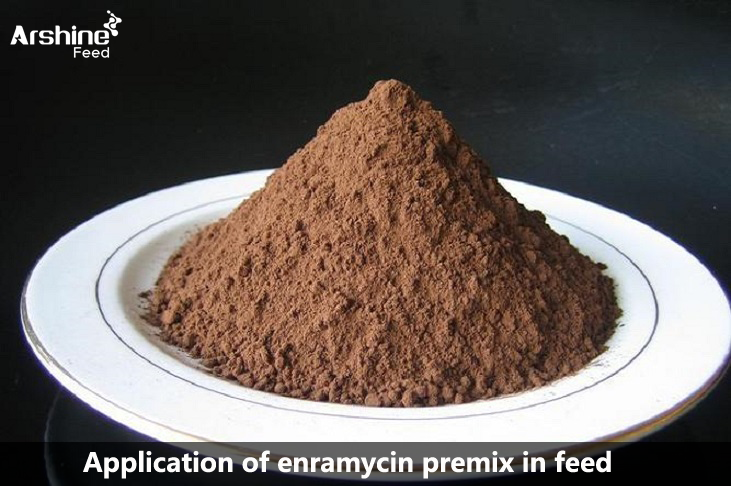

1. Introduction:
Enramycin premix is a peptide antibiotic premix obtained by actinomycetes fermentation, which is a peptide animal antibiotic composed of 13 different types of 17 amino acid molecules and fatty acid molecules. It is white or yellowish-white powder (crude gray or gray-brown powder, with special odor), decomposed at 234 °C ~ 238 °C, soluble in dilute hydrochloric acid, slightly soluble in water, methanol, ethanol, insoluble in acetone. Enramycin has strong activity against gram-positive bacteria, especially against intestinal harmful clostridium. It is not easy to develop resistance after long-term use, because it changes the bacterial group in the intestine, so the utilization of nutrients in the feed is good, which can promote the weight gain of pigs and chickens and improve the feed conversion rate.
2. Mechanism of action:
1. Pharmacodynamic research:
Enramycin has a strong effect on gram-positive bacteria, and the main mechanism is to inhibit the synthesis of bacterial cell wall, so that the cell wall is defective, resulting in an increase in intracellular osmotic pressure, and extracellular fluid infiltrates into the bacterium, causing the bacteria to deform and swell, rupture and die. Enramycin mainly acts on the fission stage of bacteria, not only bactericidal, but also bacteriolytical. Enramycin has strong antimicrobial activity against harmful pathogens such as Clostridium, Streptococcus, Staphylococcus, and Pneumococcus in the intestine.
2. Toxicology Research:
Enramycin has very low toxicity, and acute toxicity experiments have shown that enramycin is virtually non-toxic when administered orally, subcutaneously or intramuscularly, and has no mutagenic and distortogenic effects. The results of the target animal safety study showed that enramycin was safe for oral administration
3. Drug residues:
The residue test showed that the blood concentration of traditional Chinese medicine reached a peak after about 6 hours of intramuscular injection of enramycin, and then gradually decreased, and a considerable amount of the drug was still present in the blood after 24 hours. Because the excretion of drugs into the body is slow, the residual period in the tissues is long, and it also has adverse effects on liver and kidney function, and can cause inflammatory reactions such as pain, redness and swelling at the injection site, so it is forbidden to inject drugs by internal administration in clinical practice.
Enramycin is not easily absorbed when taken internally, and the drug is mainly excreted in the stool. The results of related experiments showed that the concentration of enramycin in the blood of animals after direct administration of enramycin was below the detection limit (0.15 μg/g). Drug residues in any tissue of broiler chicken or pig were below the limit of detection (0.15 μg/g).
3. Advantages and characteristics of enramycin:
1) The small amount of feed can play a good role in promoting growth and significantly improving the feed remuneration.
2) Enramycin shows good antimicrobial effect against gram-positive bacteria regardless of aerobic and anaerobic conditions. Enramycin has a very high effect on Clostridium perfringens
Strong, the bacterium is the main cause of growth inhibition and necrotizing enteritis in pigs and chickens.
3) There is no cross-resistance to enramycin.
4) The development of drug resistance is very slow, and Clostridium perfringens resistant to enramycin has not been isolated at present.
5) Because it is not absorbed in the intestine, there is no need to worry about drug residues, and there is no withdrawal period.
6) Enramycin has stable properties in the feed and remains active even during pellet processing.
7) Enramycin can reduce the situation of loose chicken manure.
8) Enramycin can inhibit ammonia-producing microorganisms, thus reducing the concentration of ammonia in the intestines and blood of pigs and chickens, thereby reducing the concentration of ammonia in the barn.
9) Enramycin can reduce the clinical symptoms of coccidiosis, probably due to the strong inhibitory effect of enramycin on secondary infection of anaerobic bacteria.
Fourth, the application of enlamycin in feed:
1. Recommended use of 4% enramycin in chicken feed:
1) Commercial broiler: used throughout the process
0-14 days old (chick stage): 200-250g/ton;
15-25 days old (young chicken stage): 150-250g/ton;
36 days old to slaughter (breeding stage): 100-150g/ton;
Medium and small chick stage with anticoccidial drugs: Hainanmycin, monensin, salinomycin.
2) Broiler breeders:
From 17 weeks to 21 weeks, 150g/ton of full-price material was added when the young chickens were refeeded, and they were used for 30 days;
From 25 weeks to 29 weeks, 150g/ton of full-price material was added when changing the peak egg production material for 30 days;
3) Laying hens:
Egg laying period, 100g-150g/ton full price feed.
2. Recommended application of 4% enramycin in pig feed:
Enramycin mixture has the effect of promoting growth and improving feed remuneration for both piglets and finishing pigs. According to statistics, the addition of enramycin to the feed can increase the weight of pigs by 16% and the feed conversion rate by 9%.
1) The use of full-price feed for suckling piglets: to prevent diarrhea and promote growth;
Enramycin 200-400g/ton + salinomycin 500g/ton;
Enramycin 200-400g/ton + antichlorine 400g/ton;
Enramycin 150-200g/ton, can be used alone;
2) The use of full-price feed for sows: prevent sow flatulence disease and improve lactation ability;
Enramycin: 200-250g/ton, improve the lactation of sows and the amount of weaning litters of suckling pigs.
Add: Block 14, No.100, Luyun Road,Changsha 410205,China.
Mobile: +86 18874001228
Email: info@arshinefeed.com
WhatsApp: 8618874001228
WeChat: weiyuyan91